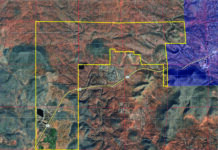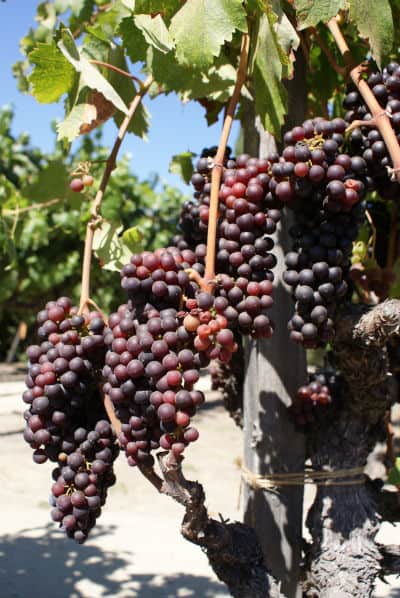Eureka. The Verde Valley has found a valuable niche with viticulture.
Finding an economic niche is like finding gold. For an economy that is mostly tourism-based, viticulture, the art of growing grapes in a way that’s favorable to winemaking, creates one more reason for people to come to the Verde Valley — and offers a product to sell.
In fact, with the number of wineries springing up in Sedona and the Verde Valley, a person can take a tour to visit them and taste their products. Currently there are seven vineyards.
One more will sprout soon, if plans keep moving forward. A long-range goal for Yavapai College Verde Campus is to expand into a full-fledged winery with up to 60 or more acres of grape vines.
The campus offers courses to educate the community on the local wines that are part of the Verde Valley’s history while getting them prepared for a growing industry that will play a large role in the regional economy.
One of the college’s viticulture instructors, Nikki Check, said she intends to start planting the first acre of wine grapes on the campus this spring.
“We’re putting in negro amaro grapes which should grow well here. They’re grown in Sicily and if you look at a world map, we’re very close in latitude here. The vineyard will be integrated into the class,” said Check, who teaches Introduction to Viticulture. “I know the students are anxious to work in and be a part of an emerging vineyard.”
The next session of Introduction to Viticulture will be offered in the fall beginning Thursday, Aug. 26.
Check studied agriculture for five years, starting at Yavapai College and went on to study agroecology at Prescott College. Currently she is managing several vineyards in the Verde Valley.
According to Paula Woolsey, another viticulture instructor for Yavapai College, the Verde Valley is perfect for growing wine grapes because of the latitude and altitude.
“Grapes grow naturally here. They come from the desert — they’re a desert plant and they are low water users. The reason we have good grapes is we plant above 3,500 feet, high desert where the diurnal shift is more drastic. It’s cold in the morning and hot in the afternoon. Grapes appreciate that shift,” Woolsey said. “If you look at a world map at where the wine regions are and go across, Arizona is right there.”
The Verde Valley ranges from 34.7 degrees and 34.8 degrees north latitude, whereas Sicily is 37.3 degrees north, France is between 43.3 and 47 degrees north, which Spain is around 37 degrees north latitude.
The Verde Valley also has great soil for grape growing in many areas, rich in calcium and other nutrients upon which grapes thrive. Grape plants also send their roots deep, even 20-plus feet, to get water and pick up nutrients and minerals along the way.
“There are super spots and the Verde campus is one of them,” Woolsey said.
The campus is located on a large piece of land in the foothills of Mingus Mountain off Black Hills Drive in Clarkdale. Only a few acres are currently used, according to Executive Dean Tom Schumacher, who was instrumental in bringing viticulture classes to the campus.
“Viticulture is brand new this year at the college. Our president, James Horton, asked me to find a niche. I went to [University of California] Davis, which is an agriculture-based school. It’s the ‘go-to’ place for wine classes. They have vineyards and a complete winery. I thought why couldn’t we do this at Yavapai College? Our campus is located in an area that is good for grape growing,” Schumacher said. “We can become what UC Davis is. Plus there’s an interest. Every class has been full.”
Schumacher said the college, because of involvement with the Verde Valley Wine Consortium, anticipated the classes would be filled with its members, but found most of the students were members of the community not necessary involved with the consortium but with a huge interest in the subject.
“Grapes are the perfect sustainable crop, and we have a perfect area to grow them,” Schumacher said. The plan for the vineyard is to use reclaimed water and power everything with solar energy. The vineyard could turn out to be one of the greenest in the nation.
“We could even get a cooper in this area and apprentice people to make wine barrels,” Woolsey said.
Woolsey is just finishing her class on Wines of the World. Beginning Wednesday, May 5, she will start her new class, Wines of the United States. The class will start with California and move up the coast to Oregon and Washington as well as Arizona.
Woolsey has a vast background in grapes, wine and winemaking beginning with her father who was in the wine business. She also has degrees from various countries related to wine, including Italy, and is a member of the Society of Wine Educators. She ran and co-owned the Asylum restaurant in Jerome with her husband Eric Woolsey. They sold the restaurant in July and she moved on to working in the wine industry and teaching.
Most recently she and Tom Pitts are co-teaching a Wine Appreciation course that began April 5 in Sedona.
“We plan to make it an ongoing class. It’s very popular. I have people coming from Phoenix to take the class,” Woolsey said. Participants will have the chance to taste different wines, so they must be 21 years or older to enroll.
On Sunday, April 11, Woolsey will help host a screening of the movie “Blood Into Wine” that was made in the Verde Valley. There will be a bottle signing and wine tasting at the Old Town Cottonwood Civic Center, 805 N. Main St.
Some advice Woolsey and Check gave for people growing grapes in the Verde Valley is to not worry if the vines still look like sticks. The grapes are just starting to bud.
“They go dormant in the winter and you don’t have to water them heavily or often, except when you’re starting new vines, but still be careful. They like to dry out between waterings. “Overwatering hinders the growth,” Check said. “Grapes here will be ready to harvest from mid-August through October, depending on the variety.”



















